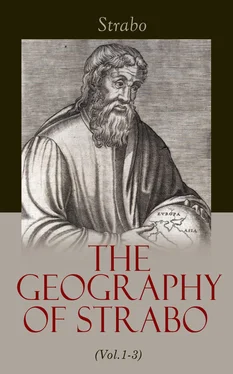To this we reply, that Eratosthenes, as is usual in Geography, speaks of right lines, meridians, and parallels to the equator, with considerable latitude, whereas Hipparchus criticizes him with geometrical nicety, as if every line had been measured with rule and compass. Hipparchus at the same time himself frequently deciding as to right lines and parallels, not by actual measurement, but mere conjecture. Such is the first error of this writer. A second is, that he never lays down the distances as Eratosthenes has given them, nor yet reasons on the data furnished by that writer, but from mere assumptions of his own coinage. Thus, where Eratosthenes states that the distance from the mouth of the [Thracian Bosphorus] to the Phasis is 8000 stadia, from thence to Dioscurias 600 stadia, 605and from Dioscurias to Caspius five days’ journey, (which Hipparchus estimates at 1000 stadia,) the sum of these, as stated by Eratosthenes, would amount to 9600 stadia. This Hipparchus abridges in the following manner. From the Cyaneæ to the Phasis are 5600 stadia, and from the Phasis to the Caspius 1000 more. 606Therefore it is no statement of Eratosthenes that the Caspius and Thapsacus are under the same meridian, but of Hipparchus himself. However, supposing Eratosthenes says so, does it follow that the distance from the Caspius to the Caspian Gates, and that from Thapsacus to the same point, are equal. 607
40. In the second book of his Commentaries, Hipparchus, having again mooted the question concerning the mountains of the Taurus, of which we have spoken sufficiently, proceeds with the northern parts of the habitable earth. He then notices the statement of Eratosthenes concerning the countries situated west of the Euxine, 608namely, that the three [principal] headlands [of this continent], the first the Peloponnesian, the second the Italian, the third the Ligurian, run from north [to south], enclosing the Adriatic and Tyrrhenian Gulfs. 609After this general exposition, Hipparchus proceeds to criticise each point in detail, but rather on geometrical than geographical grounds; on these subjects, however, the number of Eratosthenes’ errors is so overwhelming, as also of Timosthenes the author of the Treatise on the Ports, (whom Eratosthenes prefers above every other writer, though he often decides even against him,) that it does not seem to be worth my time to review their faulty productions, nor even what Hipparchus has to say about them; since he neither enumerates all their blunders, nor yet sets them right, but only points out how they falsify and contradict each other. Still any one might certainly object to the saying of Eratosthenes, that Europe has but three headlands, and considering as one that which terminates by the Peloponnesus, notwithstanding it is broken up into so many divisions. In fact, Sunium 610is as much a promontory as Laconia, and not very much less south than Malea, 611forming a considerable bay, 612and the Thracian Chersonesus 613and Sunium 614form the Gulf of Melas, 615and likewise those of Macedonia. 616Added to this, it is manifest that the majority of the distances are falsely stated, thus arguing an ignorance of geography scarcely credible, and so far from requiring geometrical demonstration that it stands out prominent on the very face of the statements. For example, the distance from Epidamnus 617to the Thermaic Gulf 618is above 2000 stadia; Eratosthenes gives it at 900. So too he states the distance from Alexandria to Carthage at 13,000 619stadia; it is not more than 9000, that is, if, as he himself tells us, Caria and Rhodes are under the same meridian as Alexandria, 620and the Strait of Messina under the same as Carthage, 621for every one is agreed that the voyage from Caria to the Strait of Sicily does not exceed 9000 stadia.
It is doubtless permissible in very great distances to consider as under one and the same meridian places which are not more east and west of each other than Carthage is west of the Strait; 622but an error of 3000 stadia is too much; and when he places Rome under the same meridian as Carthage, notwithstanding its being so far west of that city, it is but the crowning proof of his extreme ignorance both of these places, and likewise of the other countries farther west as far as the Pillars of Hercules.
41. Since Hipparchus does not furnish a Geography of his own, but merely reviews what is said in that of Eratosthenes, he ought to have gone farther, and corrected the whole of that writer’s mistakes. As for ourselves, it is only in those particulars where Eratosthenes is correct (and we acknowledge that he frequently errs) that we have thought it our duty to quote his own words, in order to reinstate them in their position, and to defend him when he could be acquitted of the charges of Hipparchus; never failing to break a lance with the latter writer whenever his objections seemed to be the result of a mere propensity to find fault. But when Eratosthenes is grossly mistaken, and the animadversions of Hipparchus are just, we have thought it sufficient in our Geography to set him (Eratosthenes) right by merely stating facts as they are. As the mistakes were so continual and numerous, it was better not to mention them except in a sparse and general manner. This principle in the details we shall strive to carry out. In the present instance we shall only remark, that Timosthenes, Eratosthenes, and those who preceded them, were but ill acquainted with Iberia and Keltica, 623and a thousand times less with Germany, Britain, and the land of the Getæ and Bastarnæ. 624Their want of knowledge is also great in regard to Italy, the Adriatic, the Euxine, and the countries north of these. Possibly this last remark may be regarded as captious, since Eratosthenes states, that as to distant countries, he has merely given the admeasurements as he finds them supplied by others, without vouching for their accuracy, although he sometimes adds whether the route indicated is more or less in a right line. We should not therefore subject to a too rigorous examination distances as to which no one is agreed, after the manner Hipparchus does, both in regard to the places already mentioned, and also to those of which Eratosthenes has given the distance from Hyrcania to Bactria and the countries beyond, and those from Colchis to the Sea of Hyrcania. These are points where we should not scrutinize him so narrowly as [when he describes] places situated in the heart of our continent, 625or others equally well known; and even these should be regarded from a geographical rather than a geometrical point of view. Hipparchus, at the end of the second book of his Commentaries on the Geography of Eratosthenes, having found fault with certain statements relative to Ethiopia, tells us at the commencement of the third, that his strictures, though to a certain point geographical, will be mathematical for the most part. As for myself, I cannot find any geography there. To me it seems entirely mathematical; but Eratosthenes himself set the example; for he frequently runs into scientific speculations, having little to do with the subject in hand, and which result in vague and inexact conclusions. Thus he is a mathematician in geography, and in mathematics a geographer; and so lies open to the attacks of both parties. In this third book, both he and Timosthenes get such severe justice, that there seems nothing left for us to do; Hipparchus is quite enough.
Table of Contents
1. We will now proceed to examine the statements made by Posidonius in his Treatise on the Ocean. This Treatise contains much geographical information, sometimes given in a manner conformable to the subject, at others too mathematical. It will not, therefore, be amiss to look into some of his statements, both now and afterwards, as opportunity occurs, taking care to confine ourselves within bounds. He deals simply with geography, when he tells us that the earth is spheroidal and the universe too, and admits the necessary consequences of this hypothesis, one of which is, that the earth contains five zones.
Читать дальше












![Anne Blunt - A Pilgrimage to Nejd, the Cradle of the Arab Race. Vol. 2 [of 2]](/books/750183/anne-blunt-a-pilgrimage-to-nejd-the-cradle-of-the-thumb.webp)